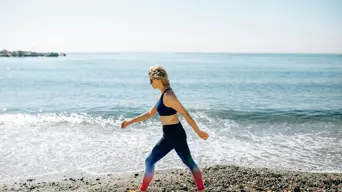Distance walking: Why it's important to warm up AND cool down (702's Walk the Talk is around the corner!)
Walking is something many of us take for granted, but when walking long distances, the right cool-down routine is as important as the right warm-up routine.

Woman walking on a beach, exercise, fitness. Pexels/Nataliya Vaitkevich
Derek Archer, Director at Fitpro-Institute of Fitness Professionals, joins 702's Gugs Mhlungu.
When taking up distance walking, it's important to know how to warm up and cool down properly to avoid any post-walk strain. (Remember 702's Walk the Talk is just around the corner!)
RELATED: Excitement is building ahead of 702 Walk the Talk 2025: Get your tickets NOW!
Derek Archer's advice to anyone looking to take up distance-walking covers everything from what kind of shoe you should opt for, the importance of staying hydrated, which muscles are affected and how to care for them properly, as well as what warning signs to look out for to avoid injury.
On the muscle groups that are used while walking, Archer says it's mainly the various leg muscles that get involved, but as you start picking up the pace, the upper body gets activated as well.
"If you're just taking a nice, slow amble, you're working your glutes, your quads, your calf structure, your hamstrings, maybe not swinging your arms as much; so not as much upper body involvement, but as you start walking with a little bit more intent you bring in the whole upper body as well."
Derek Archer, Director - Fitpro
Naturally, the first area of concern when prepping for a walk is the feet, and so having a good pair of shoes is vital. Basic sport shoes aren't ideal as they don't always offer the best padding or support, Archer says.
With so many different specialised shoes on the market, finding the right one for you is a good idea.
Cross-trainers are a good starting point as they offer more padding and support, and minimise foot-movement within the shoe.
However, if this is something you're considering taking up on a more regular basis, Archer recommends going to a sport or running-specific shop and asking the staff on the floor for their advice.
Since the walk is taking place at the end of July when temperatures are still low, Archer recommends wearing warm socks, long pants, and layers on the upper-body that you can take off as your body-temperature rises.
Adding to that, he adds the importance of staying hydrated, even if it might seem like you're not dehydrating.
"Any time our body is producing energy for exertion, or even to just exist, one of the byproducts of that energy production is water, so every time we exhale we are basically dehydrating ourselves to a small extent ... but over a long period of time that becomes a lot."
Derek Archer, Director - Fitpro
Walking is a basic part of life, and so something we take for granted as an activity that doesn't need warm-ups, stretching, or even a cool-down. Archer is quick to remind that this isn't casual walking, there's a bit more intent, which means higher demand on the body.
His advice is to start with dynamic stretching, which is movement-based.
"You don't want to hold stretches, you just want to be able to move comfortably through each joint. Even a couple of squat movements, a squat or a couple of lunges. If you did four or five lunges per leg... it opens up the joints, opens up your hips, stretches across the muscles that cover your knees, your ankles."
Derek Archer, Director - Fitpro
Since most of us have less-than-ideal postures - rounded shoulders and chins forward - it's important to open up the chest to get a good posture to make the walk easier. Shoulder rolls and swinging your arms back are good ways of achieving a good posture.
After the walk, Archer advises doing some static stretching around the calves, hamstrings, glutes, and quads to help with recovery. He says this should be done before you get back in the car, and your muscles settle in that seated position.
Naturally, one wants to avoid injury, and Archer has some key warning signs to look out for:
"If you're walking, and you start to get a sharp stabbing pain in a muscle that's been pulled or strained, that's not a good thing, that's when you should maybe stop or pull across to the side or maybe slow your pace down... sometimes guys get that ITB syndrome which runners get which is where, on the outside of the knee, just below the knee joint... that starts to burn and it becomes very sore."
Derek Archer, Director - Fitpro
Further signs that you should stop include feeling a muscle snap, or losing function in your legs.
Scroll up to the audio player to hear Archer's detailed advice